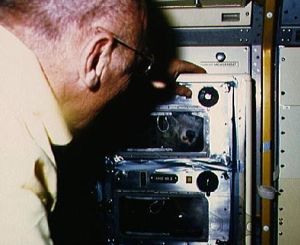
Home - Search - Browse - Alphabetic Index: 0- 1- 2- 3- 4- 5- 6- 7- 8- 9
A- B- C- D- E- F- G- H- I- J- K- L- M- N- O- P- Q- R- S- T- U- V- W- X- Y- Z
STS-51-B

STS-51-B
Spacelab D-1 being installed in the Challenger payload bay
Credit: NASA
AKA: Challenger;Spacelab 3. Launched: 1985-04-29. Returned: 1985-05-06. Number crew: 7 . Duration: 7.01 days.
Payloads: Spacelab-3 experiments, habitable Spacelab and mission peculiar experiment support structure. The experiments represented a total of five different disciplines: materials processing in space, environmental observations, life science, astrophysics, and technology experiments. Two getaway specials (GAS). The flight crew was split into gold and silver shifts working 12-hour days during the flight.
Orbits of Earth: 110. Distance traveled: 4,651,620 km. Orbiter Mass at Landing: 96,370 kg. Payload to Orbit: 14,245 kg. Payload Returned: 14,198 kg. Landed at: Runway 17 dry lake bed at Edwards Air Force Base, . Landing Speed: 378 kph. Touchdown miss distance: 480 m. Landing Rollout: 2,535 m.
NASA Official Mission Narrative
Mission Name: 51-B (17)
CHALLENGER (7)
Pad 39-A (29)
17th Shuttle mission
7th Flight OV-O99
3rd Rollback
Crew:
Robert F. Overmyer (2), Commander
Frederick D. Gregory (1), Pilot
Don L. Lind (1), Mission Specialist 1
Norman E. Thagard (2), Mission Specialist 2
William E. Thornton (2), Mission Specialist 3
Lodewijk van den Berg (1), Payload Specialist 1
Taylor G. Wang (1), Payload Specialist 2
Milestones:
Flow A:
OPF - Oct. 13,1984
VAB - Feb. 10,1985
PAD - Feb. 15,1985
Flow B (rollback):
VAB - March 4,1985
OPF - March 7, 1985
VAB - April 10,1985
PAD - April 15, 1985
Payload:
SPACELAB-3
Mission Objectives:
Launch:
April 29,1985,12:02:18 p.m. EDT. Flight first manifested as 51-E; rolled back from pad due to timing problem with TDRS-B payload. Mission 51-E cancelled; orbiter remanifested with 51-B payloads. Launch April 29 delayed two minutes,18 seconds due to a launch processing system failure. Launch Weight: 246,880 lbs.
Orbit:
Altitude: 222nm
Inclination: 57.0 degrees
Orbits: 111
Duration: Seven days zero hours, eight minutes, 46 seconds.
Distance: 2,890,383 miles
Hardware:
SRB: BI-016
SRM: L016(HPM)
ET : 17/LWT-10
MLP : 2
SSME-1: SN-2023
SSME-2: SN-2020
SSME-3: SN-2021
Landing:
May 6, 1985,9:11:04 a.m. PDT, Runway 17, Edwards Air Force Base, Calif. Rollout distance: 8.317 feet. Rollout time: 59 seconds. First Crosswind Landing. Orbiter returned to KSC May 11,1985. Landing Weight: 212,465 lbs.
Mission Highlights:
Primary payload was Spacelab-3. First operational flight for Spacelab orbital laboratory series developed by European Space Agency. Five basic discipline areas: materials sciences, life sciences, fluid mechanics, atmospheric physics. And astronomy main mission objective with Spacelab-3 was to provide high quality microgravity environment for delicate materials processing and fluid experiments. Two monkeys and 24 rodents observed for effects of weightlessness. Of 15 Spacelab primary experiments conducted, 14 considered successful. Two Get Away Specials on board.
More at: STS-51-B.
Family: Manned spaceflight. People: Gregory, Lind, Overmyer, Thagard, Thornton, Bill, van den Berg, Lodewijk, Wang. Country: USA. Spacecraft: Challenger. Projects: STS. Launch Sites: Cape Canaveral. Agency: NASA, NASA Houston. Bibliography: 4457.
 | STS-51-B Artist concept of Spacelab in orbiter cargo bay with horizon Credit: NASA |
 | STS-51-B Lift-off of shuttle Challenger and mission STS 51-B Credit: NASA |
 | STS-51-B Aurora over the Southern Hemisphere Credit: NASA |
 | STS-51-B Astronaut Norman Thagard rests on middeck while other team is on duty Credit: NASA |
 | STS-51-B Astronaut William Thornton observes monkey in the RAHF Credit: NASA |
 | STS-51-B Payload specialist Lodewijk van den Berg looks out aft flight deck window Credit: NASA |
1985 April 29 - . 16:02 GMT - . Launch Site: Cape Canaveral. Launch Complex: Cape Canaveral LC39A. Launch Platform: MLP2. LV Family: Shuttle. Launch Vehicle: Space Shuttle.
- STS-51-B - .
Call Sign: Challenger. Crew: Gregory,
Lind,
Overmyer,
Thagard,
Thornton, Bill,
van den Berg, Lodewijk,
Wang.
Payload: Challenger F07 / SL 3 MPESS. Mass: 14,245 kg (31,404 lb). Nation: USA.
Related Persons: Gregory,
Lind,
Overmyer,
Thagard,
Thornton, Bill,
van den Berg, Lodewijk,
Wang.
Agency: NASA Houston.
Program: STS.
Class: Manned.
Type: Manned spaceplane. Flight: STS-51-B.
Spacecraft Bus: Shuttle.
Spacecraft: Challenger.
Duration: 7.01 days. Decay Date: 1985-05-06 . USAF Sat Cat: 15665 . COSPAR: 1985-034A. Apogee: 353 km (219 mi). Perigee: 346 km (214 mi). Inclination: 57.00 deg. Period: 91.50 min.
Manned seven crew. Deployed Nusat; carried Spacelab 3. Payloads: Spacelab-3 experiments, habitable Spacelab and mission peculiar experiment support structure. The experiments represented a total of five different disciplines: materials processing in space, environmental observa-tions, life science, astrophysics, and technology experiments. Two getaway specials (GAS). The flight crew was split into gold and silver shifts working 12-hour days during the flight.
1985 May 6 - .
- Landing of STS-51-B - . Return Crew: Gregory, Lind, Overmyer, Thagard, Thornton, Bill, van den Berg, Lodewijk, Wang. Nation: USA. Related Persons: Gregory, Lind, Overmyer, Thagard, Thornton, Bill, van den Berg, Lodewijk, Wang. Program: Spacelab. Flight: STS-51-B. STS-51-B landed at 16:13 GMT. .
Back to top of page
Home - Search - Browse - Alphabetic Index: 0- 1- 2- 3- 4- 5- 6- 7- 8- 9
A- B- C- D- E- F- G- H- I- J- K- L- M- N- O- P- Q- R- S- T- U- V- W- X- Y- Z
© 1997-2019 Mark Wade - Contact
© / Conditions for Use